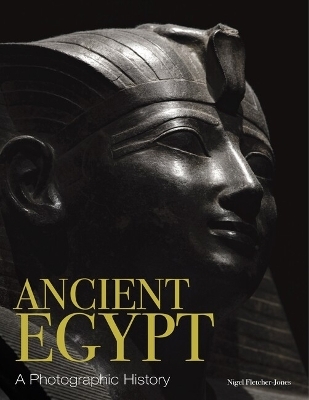
Ancient Egypt
Amber Books (Verlag)
978-1-83886-367-8 (ISBN)
First appearing around the mighty River Nile in the fourth millennium BC, Ancient Egypt is one of the great wellsprings of human civilization. Egyptian culture developed around a complex system of religious rituals tied to the agricultural seasons, with the pharaoh a living deity at the centre. Mighty pyramids, tombs and monuments were built to celebrate the pharaohs, many of which can still be seen in all their splendour today. Arranged chronologically, Ancient Egypt offers a compact photographic guide, from the 4000 BC Naqada culture to the end of the Ptolemy dynasty with the suicide of Cleopatra in 30 BC. In between, discover the Narmer Palette, a 31st century BC stone tablet that records the unification of Upper and Lower Egypt by King Narmer; learn about Amenhotep the Magnificent, during whose reign Egypt reached the peak of its artistic and international power; marvel at the massive, rock-cut temples of Abu Simbel, dedicated to Pharaoh Ramesses II (“the Great”), marking the southern extent of the Egyptian empire and celebrating his victory over the Hittites at the Battle of Kadesh; and discover how Egypt was ruled by Archaemenid Persia for almost 200 years, until the arrival of Alexander the Great and his all-conquering Macedonian army. Colourful, engaging and illustrated throughout with more than 180 photographs, Ancient Egypt is a vivid pictorial introduction to 4,000 years of Ancient Egyptian civilization.
Nigel Fletcher-Jones, with a PhD in archaeological anthropology from Durham University, UK, was director of the American University in Cairo Press from 2012 to 2020. He is the author of Treasures of Ancient Egypt (2019), Abu Simbel and the Nubian Temples (2019), and Ancient Egyptian Jewelry (2020). He lives in Canterbury, Kent.
Contents to include:
Introduction: Making a Culture (5000–3000 BC) The Nile Merimda and el-Omari cemeteries Badarians – pottery and landscape Settling and herding Naqada, Abydos and Hierakonpolis The copper trade on the lower Nile Narmer’s Palette Nekhen and the cult of Horus Naqada Mastaba Naqadan culture and migration to Upper Egypt
Early Dynastic Period (3150–2613 BCE) Before the unification of Egypt, the land was settled with autonomous villages. With the early dynasties, and for much of Egypt's history thereafter, the country came to be known as the Two Lands. It was also during this period that the Egyptian writing system was further developed. Initially, Egyptian writing had been composed primarily of a few symbols denoting amounts of various substances. By the end of the 3rd dynasty it had been expanded to include more than 200 symbols, both phonograms and ideograms. Menes: unifier of Upper and Lower Egypt
Old Kingdom (2613–2181 BCE) The Old Kingdom is perhaps best known for the large number of pyramids, which were constructed at this time as pharaonic burial places. For this reason, this epoch is frequently referred to as "the Age of the Pyramids." To organize and feed the manpower needed to create these pyramids required a centralized government with extensive powers, and Egyptologists believe the Old Kingdom at this time demonstrated this level of sophistication. Djoser: Commissioned the first Pyramid in Egypt, created by chief architect and scribe Imhotep. Sneferu: Reigned 48 years, giving him enough time to build the Meidum Pyramid, the Bent Pyramid and the Red Pyramid. Khufu: Built the Great Pyramid of Giza. Khufu is depicted as a cruel tyrant by ancient Greek authors. Menkaure; A legend claims that his only daughter died due to an illness and Menkaura buried her in a golden coffin in the shape of a cow. Neferkare: Possibly the longest reigning monarch of human history with 94 years on the throne.
First Intermediate Period (2182–2060 BCE) After the fall of the Old Kingdom came a roughly 200-year stretch of time known as the First Intermediate Period, which is generally thought to include a relatively obscure set of pharaohs running from the end of the Sixth to the Tenth and most of the Eleventh
Dynasties. By 2160 BC, a new line of pharaohs, the Ninth and Tenth Dynasties, consolidated Lower Egypt from their capital in Heracleopolis Magna. Qakare: Built a pyramid at Saqqara inscribed with the last known instance of the Pyramid Texts. Wahankh: Conquered Abydos and its nome.
Middle Kingdom (2060–1782 BCE) The earliest pharaohs of the Middle Kingdom traced their origin to two nomarchs of Thebes, Intef the Elder, who served a Heracleopolitan pharaoh of the Tenth Dynasty, and his successor, Mentuhotep I. Mentuhotep II is known to have commanded military campaigns south into Nubia, which had gained its independence during the First Intermediate Period. Mentuhtep III: Commanded the first expedition to Punt of the Middle Kingdom Senusret III (1878–1839 BC) was a warrior king, leading his troops deep into Nubia, and built a series of massive forts throughout the country to establish Egypt's formal boundaries with the unconquered areas of its territory. Amenemhat III (1860–1815 BC) is considered the last great pharaoh of the Middle Kingdom.
Second Intermediate Period (c. 1782–1570 BCE) The Second Intermediate Period marks a period when Egypt once again fell into disarray between the end of the Middle Kingdom and the start of the New Kingdom. While the Fourteenth Dynasty was Levantine, the Hyksos first appeared in Egypt c. 1650 BC when they took control of Avaris and rapidly moved south to Memphis, thereby ending the Thirteenth and Fourteenth Dynasties. The Seventeenth Dynasty and a war of liberation: The two last kings of this dynasty were Seqenenre Tao and Kamose. Ahmose I completed the conquest and expulsion of the Hyksos from the Nile Delta, restored Theban rule over the whole of Egypt and successfully reasserted Egyptian power in its formerly subject territories of Nubia and the Southern Levant.
New Kingdom (1570–1069 BCE) Eighteenth Dynasty: This was a time of great wealth and power for Egypt. Some of the most important and best-known pharaohs ruled at this time, such as Hatshepsut. Hatshepsut is unusual as she was a female pharaoh, a rare occurrence in Egyptian history. Ahmose I: conquered north of Egypt from the Hyksos. Thutmose III: Famous for his territorial expansion into the Levant and Nubia. Under his reign, the Ancient Egyptian Empire was at its greatest extent. Amenhotep III The Magnificent: Father of Akhenaten and grandfather of Tutankhamun. Ruled Egypt at the height of its power. Built many temples and monuments, including his enormous Mortuary Temple. Amenhotep IV: changed the state religion from the polytheistic Ancient Egyptian religion to the Monotheistic Atenism, centered around the worship of the Aten, an image of the sun disc Tutankhamun: He is thought to have taken the throne at around age eight or nine and to have died around age eighteen or nineteen, giving him the nickname "The Boy King." Tutankhamun was a weak ruler suffering from multiple health issues. Nineteenth Dynasty: Ramesses I reigned for two years and was succeeded by his son Seti I. Seti I carried on the work of Horemheb in restoring power, control, and respect to Egypt. Ramesses II the Great: Continued expanding Egypt's territory until he reached a stalemate with the Hittite Empire at the Battle of Kadesh in 1275 BCE The last "great" pharaoh from the New Kingdom is widely considered Ramesses III, the son of Setnakhte. He fought the Sea Peoples in 1175 BC.
Third Intermediate Period (1069–664 BCE) After the death of Ramesses XI, his successor Smendes ruled from the city of Tanis in the north, while the High Priests of Amun at Thebes had effective rule of the south of the country, whilst still nominally recognizing Smendes as king. Pasebakhenniut I: Famous for his intact tomb at Tanis. Known as "The Silver Pharaoh" due to the magnificent silver coffin he was buried in. Piye: King of Nubia; conquered Egypt in his 20th year; full reign at least 24 years, possibly 30 years Late Period (664–525 BCE) From 671 BC on, Memphis and the Delta region became the target of many attacks from the Assyrians, who expelled the Nubians and handed over power to client kings of the Twenty-Sixth Dynasty. Psamtik I was the first recognized as the king of the whole of Egypt, and he brought increased stability to the country during a 54-year reign from the new capital of Sais. However, during this period Babylonian emperor Nebuchadnezzar II (605–562 BC) campaigned against the Egyptians and drove them back over the Sinai. In 567 BC he went to war with Pharaoh Amasis, and briefly invaded Egypt itself.
Persian Egypt (525–332 BC) Achaemenid Egypt can be divided into three eras: the first period of Persian occupation, 525–404 BC (when Egypt became a satrapy), followed by an interval of independence, and the second and final period of occupation, 343–332 BC. The Persian king Cambyses assumed the formal title of Pharaoh, called himself Mesuti-Re ("Re has given birth"), and sacrificed to the Egyptian gods. Nectanebo II was the last native king to rule Egypt.
From Alexander the Great to Cleopatra (332–30 BC) In 332 BC, Mazaces handed over the country to Alexander the Great without a fight. He was welcomed by the Egyptians as a deliverer. He visited Memphis, and went on a pilgrimage to the oracle of Amun at the Siwa Oasis. Following Alexander's death in Babylon in 323 BC, a succession crisis erupted among his generals. Perdiccas ruled the empire as regent for Alexander's half-brother Arrhidaeus, who became Philip III of Macedon, and Alexander's infant son Alexander IV of Macedon. Perdiccas appointed Ptolemy, one of Alexander's closest companions, to rule Egypt in the name of the joint kings. All the male rulers of the dynasty took the name, Ptolemy. Ptolemaic queens regnant, some of whom were the sisters of their husbands, were usually called Cleopatra, Arsinoe or Berenice. The most famous member of the line was the last queen, Cleopatra VII, known for her role in the Roman political battles between Julius Caesar and Pompey, and later between Octavian and Mark Antony. Her apparent suicide at the conquest by Rome marked the end of Ptolemaic rule in Egypt.
| Erscheinungsdatum | 16.05.2024 |
|---|---|
| Reihe/Serie | History in Photographs |
| Zusatzinfo | Halftones, color |
| Sprache | englisch |
| Maße | 192 x 250 mm |
| Gewicht | 890 g |
| Themenwelt | Geschichte ► Allgemeine Geschichte ► Vor- und Frühgeschichte |
| Geschichte ► Allgemeine Geschichte ► Altertum / Antike | |
| Geisteswissenschaften ► Religion / Theologie ► Weitere Religionen | |
| ISBN-10 | 1-83886-367-2 / 1838863672 |
| ISBN-13 | 978-1-83886-367-8 / 9781838863678 |
| Zustand | Neuware |
| Informationen gemäß Produktsicherheitsverordnung (GPSR) | |
| Haben Sie eine Frage zum Produkt? |
aus dem Bereich


